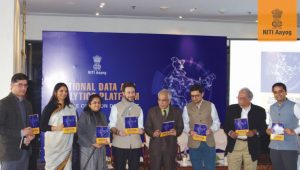 The platform aims to democratize access to publicly available government data. It will host the latest datasets from various government websites, present them coherently, and provide tools for analytics and visualization. Technology has increasingly shown the potential to fix challenges across important socio-economic fields such as financial inclusion and healthcare. A combination of data analytics, artificial intelligence, machine learning and a rising digital footprint in India has led to proliferation of products and services in society.
The platform aims to democratize access to publicly available government data. It will host the latest datasets from various government websites, present them coherently, and provide tools for analytics and visualization. Technology has increasingly shown the potential to fix challenges across important socio-economic fields such as financial inclusion and healthcare. A combination of data analytics, artificial intelligence, machine learning and a rising digital footprint in India has led to proliferation of products and services in society.
The NDAP will follow a user-centric approach and will enable data access in a simple and intuitive portal tailored to the needs of a variety of stakeholders. NDAP will spearhead the standardization of formats in which data is presented across sectors and will cater to a wide audience of policymakers, researchers, innovators, data scientists, journalists and citizens. The vision document was released by Dr Rajiv Kumar, Vice Chairman, NITI Aayog, in the presence of Amitabh Kant, CEO, NITI Aayog, senior officials from various ministries and state governments, academics and researchers.
In his opening remarks, Dr Rajiv Kumar said, “India has made tremendous progress in generating and using data for policymaking and programme implementation. It is now time to build on these efforts to further strengthen the data ecosystem. I am certain that NDAP, with its mission to be a one-stop and user-friendly data platform, will go a long way in transforming India’s data ecosystem.”
Amitabh Kant explained the context for the development of NDAP, “NITI Aayog has always promoted and championed the use of data in all spheres of governance. It is therefore natural that NITI Aayog takes the lead in providing the nation with a simple and compelling platform where various datasets can be accessed together. This has been a longstanding gap in the data ecosystem, which NITI Aayog is now seeking to try and address.’
Senior Adviser Anna Roy, who is leading this initiative within NITI Aayog, expounded the need for NDAP: ‘We are seeking to address three main gaps. One, all datasets are not published in a user-centric manner that is analyzable and visually presented. Two, there are a multitude of datasets out there that is not easily accessible. The NDAP proposes a simple, interactive, visual, and robust platform that will host various Central and state government datasets.’
An inter-ministerial committee will oversee the progress of the development of platform and a group of leading experts have been inducted into an advisory group to provide technical guidance for the development of the platform. The success of the endeavour is dependent on the cooperation and support of various stakeholders.
The development of NDAP will take place over a period of one year. The first version of the platform is expected to be launched in 2021. The process will follow a user-centric approach, and will incorporate feedback received from various users and stakeholders throughout the course of its development.
Satwik Mishra, a young professional at NITI Aayog observed that technology has increasingly shown the potential to fix challenges across important socio-economic fields such as financial inclusion and healthcare. A combination of data analytics, artificial intelligence, machine learning and a rising digital footprint in India has led to proliferation of products and services in society. As technology embraces and enhances the daily lives of people in contemporary India, people should readily return the favour, empowering themselves. Facilitating this reverse embrace of technology is essential for Indian public policy.
Another crucial component of human development and social security is affordable, accessible and effective healthcare. The challenge of healthcare lies in the shortage of 6 lakh doctors; availability and affordability of drugs; poor, slow and incorrect diagnosis and lack of universally available healthcare with ‘60 per cent hospitals, 75 per cent dispensaries and 80 per cent doctors located in urban areas servicing only 28 per cent of the country’s population’.
Technology could be the vanguard of health. E-health technologies can create a transformational shift in Indian healthcare. E-health can ‘ensure efficiency in healthcare, thereby decreasing costs, enhancing the quality of healthcare by allowing comparisons between different providers, ensuring evidence-based treatment, enabling empowerment of patients by making the knowledge base of medicine and personal electronic records accessible and also extending the scope of healthcare beyond its conventional boundaries. E-health could enable consumers to easily obtain health services online from global providers’.
Various steps are already underway in this field. NITI Aayog’s National Health Stack and recently released report on National Digital Health Blueprint by the Ministry of Health and Family Welfare has conceptualized, amongst other things, a unique health ID containing individuals’ health records, concept of regional portability in access to healthcare, digital access to doctors and hence diagnosis, and finally a standardized service delivery for ensuring high quality care.
Hence, technological advances definitely have an immense potential to fix our developmental challenges. Public policy should facilitate the substantial use of technology wherever possible for public welfare. At the same time, it should ensure that people enthusiastically and willingly use these technology products and services, for their own well-being. For this, a principled, innovative and transparent framework should be conceptualized ensuring this reverse embrace.
The first and foremost pillar of this framework should be adherence to principles-based governance. A comprehensive technology interlaced with education, healthcare, financial sector, among others, is new for people. To ensure its sustainability and to minimize its misuse, certain first principles must be universally agreed upon. These principles may involve: Notice to individuals about information collection, Security safeguards and Accountability measures to be taken by data controller, etc. For this, the data security framework and statute under consideration in Parliament should be realized with due diligence and necessary consensus creation as soon as possible.
The second pillar of this framework lies in governance avoiding path-dependence and consequently innovating in its policies. Path-dependence implies choices being limited by decisions and experiences of the past. We shouldn’t solely rely on laws, regulations and rules that haven’t been originally conceptualized to handle novel technological interventions.
Inevitably then, public policy must develop tools to innovatively and creatively engage with new technologies. Regulators must collaborate with innovators to understand technology. Innovators must cooperate with the states to bring to their cognizance the value that technological innovations can bring for society.
The European Union has conceptualized Innovation Deals for exactly this purpose: for innovators to sign voluntary deals with regulators. If there are laws, regulations or rules that are coming in the way of bringing value to society, the innovators flag it for the government. Then a collaborative attempt is made to get over such obstacles. We should consider bringing such innovation deals in India. Recently, a policy innovation in India aligned to this is the Consent Artifact conceptualized by the Ministry of Electronics and Information Technology. It would essentially be a digital consent form for data owners (users). The users would be able to give consent for use of their data and also the purposes for which it may be used.
The final pillar is ensuring transparency around the use of technology. For this, there must be comprehensive engagement with people. They must be involved in the consultation process before framing policies as well as the audit processes. Technology is essential to address the aspiration and potential of 1.3 billion Indians. New India is witnessing technological expansion on the supply side. It is time to ensure that public policies and regulations substantially facilitate and value technology for its potential in socio-economic development. This would beneficially bring about the transformative reverse embrace of technology from the demand side.
letters@tehelka.com












